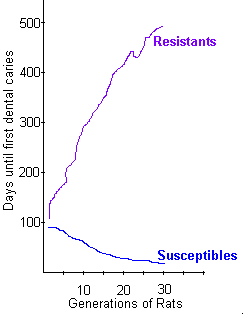Bacteria.
It is difficult (impossible?) to comprehend the number of bacteria
in our environment. Some of them carry genes that help them survive
the attack of an antibiotic. Each year there are reports of antibiotic
resistance in another bacteria and each year industry seems to
come out with a new antibiotic. It is in no way certain who will
win the race between the evolution of bacteria and the ability
of chemists to develop new antibiotics.
Of course, not all selection is accidental. We already mentioned
the artificial selection that plant and animal breeders have been
using for centuries. Those domestic strains took many years to
produce and were not conducted as experiments.
However, selection isn't excluded from laboratory experimentation.
One particularly interesting experiment in evolution used the
laboratory rat to study tooth decay. Bacteria are the cause of
tooth decay (also called "dental caries") and many genes
are involved in fighting them. This was a carefully conducted
breeding experiment to produce two different strains of rats -
one strain highly susceptible and the other strain highly resistant
(to tooth decay).
The scientists divided a population of rats into two different
groups.
Those most resistant to tooth decay took over 100 days (on average)
to develop dental caries.
The least resistant group developed caries in about 80 days.
The rats within each group were bred to produce the next generation
of rats.
Resistant rats were bred only with other resistant rats and susceptible
rats bred only with susceptible rats.
Their offspring were selected to be either resistant or susceptible
to dental caries and bred with similar rats through the generations.
After 20 generations the scientists had developed two strains
of rat.
The resistant rats took over 400 days (on average) to develop
caries but the susceptible rats developed caries in less than
50 days (on average). | 
|
[This graph is compiled from data presented by Hunt HR, Hoppert, CA and S Rosen. Genetic Factors in Experimental Rat Carries. Advances in Experimenal caries Research 1955 pp 66-81.
The scientists had no idea what genes are responsible for fighting
caries, but in a relatively short period of time they had produced
two different strains of rat by selecting the traits they wanted. That
eight fold difference in tooth decay is a remarkable example of
evolution and it was all done in the controlled conditions of
a laboratory.
All these examples shown evolution occurring due to selection -
natural or otherwise.
But are they examples of the evolution of species?
Yes.
No.
This work was created by Dr Jamie Love  and
and  licensed under a Creative Commons Attribution-ShareAlike 4.0 International License.
licensed under a Creative Commons Attribution-ShareAlike 4.0 International License.
If you like, you can return to the Home Page.

 and
and  licensed under a Creative Commons Attribution-ShareAlike 4.0 International License.
licensed under a Creative Commons Attribution-ShareAlike 4.0 International License.